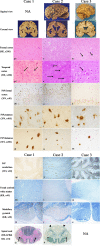An autopsy report of three kindred in a Gerstmann-Sträussler-Scheinker disease P105L family with a special reference to prion protein, tau, and beta-amyloid
- PMID: 30240140
- PMCID: PMC6192393
- DOI: 10.1002/brb3.1117
An autopsy report of three kindred in a Gerstmann-Sträussler-Scheinker disease P105L family with a special reference to prion protein, tau, and beta-amyloid
Abstract
Introduction: Gerstmann-Sträussler-Scheinker disease P105L (GSS105) is a rare variant of GSS caused by a point mutation of the prion protein (PrP) gene at codon 105 (proline to leucine substitution). It is clinically characterized by spastic paraparesis and dementia and histopathologically defined by PrP-plaques in the brain. This report describes a clinicopathological analysis of three autopsied kindred from a Japanese GSS105 family, plus a topological analysis of PrP, hyperphosphorylated tau (p-tau), and beta-amyloid (Aβ).
Methods: Using paraffin-embedded sections, we applied histology and single- and multiple-labeling immunohistochemistry for PrP, p-tau, and Aβ to the three cases. Comparative semi-quantitative analyses of tissue injuries and PrP-plaques were also employed.
Results: Case 1 (45 years old (yo)) and Case 2 (56 yo) are sisters, and Case 3 (49 yo) is the son of Case 2. Case 1 and Case 2 presented with spastic paraparesis followed by dementia, whereas Case 3 presented, not with spastic paraparesis, but with psychiatric symptoms. In Case 1 and Case 2, the brain showed tissue injuries with many PrP-plaques in the cerebral cortices, and the pyramidal tract showed myelin loss/pallor. In Case 3, the brain was least degenerated with a number of PrP-plaques; however, the pyramidal tract remained intact. In addition, p-tau was deposited in all cases, where p-tau was present in or around PrP-plaques. By double-labeling immunohistochemistry, the colocalization of p-tau with PrP-plaques was confirmed. Moreover in Case 2, Aβ was deposited in the cerebral cortices. Interestingly, not only p-tau but also Aβ was colocalized with PrP-plaques. In all cases, both three repeat tau and four repeat tau were associated with PrP-plaques.
Conclusions: The clinicopathological diversity of GSS105, which is possible even in the same family, was ascertained. Not only p-tau but also Aβ could be induced by PrP ("secondary degeneration"), facilitating the kaleidoscopic symptoms of GSS.
Keywords: Gerstmann-Sträussler-Scheinker disease P105L; autopsy; beta-amyloid; prion protein; spastic paraparesis; tau.
© 2018 The Authors. Brain and Behavior published by Wiley Periodicals, Inc.
Figures






Similar articles
-
Specific amyloid-β42 deposition in the brain of a Gerstmann-Sträussler-Scheinker disease patient with a P105L mutation on the prion protein gene.Prion. 2018;12(5-6):315-319. doi: 10.1080/19336896.2018.1541689. Epub 2018 Nov 13. Prion. 2018. PMID: 30394185 Free PMC article.
-
Hyperphosphorylated tau deposition parallels prion protein burden in a case of Gerstmann-Sträussler-Scheinker syndrome P102L mutation complicated with dementia.Acta Neuropathol. 2002 Oct;104(4):342-50. doi: 10.1007/s00401-002-0547-3. Epub 2002 May 14. Acta Neuropathol. 2002. PMID: 12200619
-
Extracellular Prion Protein Aggregates in Nine Gerstmann-Sträussler-Scheinker Syndrome Subjects with Mutation P102L: A Micromorphological Study and Comparison with Literature Data.Int J Mol Sci. 2021 Dec 10;22(24):13303. doi: 10.3390/ijms222413303. Int J Mol Sci. 2021. PMID: 34948096 Free PMC article.
-
A variant of Gerstmann-Sträussler-Scheinker disease carrying codon 105 mutation with codon 129 polymorphism of the prion protein gene: a clinicopathological study.J Neurol Sci. 1994 Dec 1;127(1):77-86. doi: 10.1016/0022-510x(94)90138-4. J Neurol Sci. 1994. PMID: 7699395 Review.
-
How an Infection of Sheep Revealed Prion Mechanisms in Alzheimer's Disease and Other Neurodegenerative Disorders.Int J Mol Sci. 2021 May 4;22(9):4861. doi: 10.3390/ijms22094861. Int J Mol Sci. 2021. PMID: 34064393 Free PMC article. Review.
Cited by
-
PRNP E146G mutation inherited prion disease: distinctive clinical, pathological and fluid biomarker features.J Neurol. 2025 Mar 29;272(4):299. doi: 10.1007/s00415-025-13022-2. J Neurol. 2025. PMID: 40156621 Free PMC article.
-
A patient with spastic paralysis finally diagnosed as V180I genetic Creutzfeldt-Jakob disease 9 years after onset.Prion. 2020 Dec;14(1):226-231. doi: 10.1080/19336896.2020.1823179. Prion. 2020. PMID: 32938301 Free PMC article.
-
Gerstmann-Sträussler-Scheinker Disease Presenting as Late-Onset Slowly Progressive Spinocerebellar Ataxia, and Comparative Case Series with Neuropathology.Mov Disord Clin Pract. 2024 Apr;11(4):411-423. doi: 10.1002/mdc3.13976. Epub 2024 Jan 23. Mov Disord Clin Pract. 2024. PMID: 38258626 Free PMC article.
-
Prion Mutations in Republic of Republic of Korea, China, and Japan.Int J Mol Sci. 2022 Dec 30;24(1):625. doi: 10.3390/ijms24010625. Int J Mol Sci. 2022. PMID: 36614069 Free PMC article. Review.
-
Extracellular Protein Aggregates Colocalization and Neuronal Dystrophy in Comorbid Alzheimer's and Creutzfeldt-Jakob Disease: A Micromorphological Pilot Study on 20 Brains.Int J Mol Sci. 2021 Feb 20;22(4):2099. doi: 10.3390/ijms22042099. Int J Mol Sci. 2021. PMID: 33672582 Free PMC article.
References
-
- Alzualde, A. , Indakoetxea, B. , Ferrer, I. , Moreno, F. , Barandiaran, M. , Gorostidi, A. , … Lopez de Munain, A. (2010). A novel PRNP Y218N mutation in Gerstmann‐Sträussler‐Scheinker disease with neurofibrillary degeneration. Journal of Neuropathology & Experimental Neurololgy, 69, 789–800. 10.1097/NEN.0b013e3181e85737. - DOI - PubMed
-
- Amano, N. , Yagishita, S. , Yokoi, S. , Itoh, Y. , Kinoshita, J. , Mizutani, T. , … Matsuishi, T. (1992). Gerstmann‐Sträussler syndrome‐A variant type: Amyloid plaques and Alzheimer's neurofibrillary tangles in cerebral cortex. Acta Neuropathologica, 84, 15–23. - PubMed
-
- Bugiani, O. , Giaccone, G. , Verga, L. , Pollo, B. , Frangione, B. , Farlow, M. R. , … Ghetti, B. (1993). Beta PP participates in PrP‐amyloid plaques of Gerstmann‐Sträussler‐Scheinker disease, Indiana kindred. Journal of Neuropathology & Experimental Neurology, 52, 64–70. - PubMed
-
- Colucci, M. , Moleres, F. J. , Xie, Z. L. , Ray‐Chaudhury, A. , Gutti, S. , Butefisch, C. M. , … Gambetti, P. (2006). Gerstmann‐Sträussler‐Scheinker: A new phenotype with 'curly' PrP deposits. Journal of Neuropathology & Experimental Neurology, 65, 642–651. 10.1097/01.jnen.0000228198.81797.4d - DOI - PubMed
-
- de Silva, R. , Lashley, T. , Gibb, G. , Hanger, D. , Hope, A. , Reid, A. , … Lees, A. (2003). Pathological inclusion bodies in tauopathies contain distinct complements of tau with three or four microtubule‐binding repeat domains as demonstrated by new specific monoclonal antibodies. Neuropathology and Applied Neurobiology, 29, 288–302. 10.1046/j.1365-2990.2003.00463.x - DOI - PubMed
Publication types
MeSH terms
Substances
LinkOut - more resources
Full Text Sources
Other Literature Sources
Research Materials
Miscellaneous

